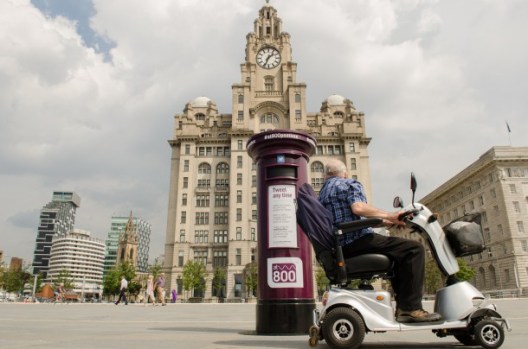By Paul Hemsley
Holroyd City Council’s push for the state government to crackdown on motorised scooter use has been rejected at the Local Government and Shires Associations of New South Wales (LGSA) Conference in Dubbo.
This loss is a roadblock for local government calls for tougher regulation of the use of motorised scooters and electric wheelchairs following a series of accidents involving scooter drivers, road users and pedestrians.
It means the council’s request for licencing users and a clear differentiation between pedestrians and motorised scooters will not receive the attention of the NSW government through the LGSA.
The council’s submission called for the NSW government to require motorised scooter owners to obtain a ‘Certificate of Ownership and Competence’.
Its original submission to the LGSA said that it was concerned about the “lack of controls and skills of elderly people and other needy persons”.
It said “these people create a public hazard” by riding motorised scooters and electric wheelchairs on paths and roads without any regulator controls imposed on the scooters or the drivers.
Holroyd has not been the lone voice among local councils to push a state government to introduce regulations on scooter use.
In March 2012, Ballina Shire Council made a call for the state government to regulate scooter use by writing to Ballina MP Don Page about the lack of legislation on their use.
Later in October 2012, an accident occurred in the Ballina area where a 92-year-old woman on a motorised scooter ploughed into the back of two elderly pedestrians, causing serious injuries.
In July 2012, the car in which Federal Opposition Leader Tony Abbott was travelling in Brisbane collided with a scooter, breaking the rider’s leg as she was knocked off. Mr Abbott was unharmed.
Regulations on motorised scooters are already strict as the NSW Roads and Maritime Service (RMS) states that the vehicles with or without seats are banned on roads and public areas.
Comment below to have your say on this story.
If you have a news story or tip-off, get in touch at editorial@governmentnews.com.au.
Sign up to the Government News newsletter



Motorised wheel chairs are not classified as vehicles unless they are capable of a speed greater than 10km per hour. (Any that breach this threshold are classed as vehicles but are not eligible for registration because they do not meet sufficient safety requirements to be operated on the road network.) Wheelchairs are designed as mobility aids and as such the operators are subject to the same rules as any other pedestrian. They are certainly not banned from roads and public areas even though they are not meant to be operated on roads like vehicles.
The term motorised scooter is somewhat misleading because it can be confused with registerable two wheeled vehicles. See details at http://www.rta.nsw.gov.au/roadsafety/pedestrians/motorisedwheelchairs.html
and http://www.rta.nsw.gov.au/registration/unregisteredvehicles/scootersminibikes.html
Local authorities have legitimate concerns about the capacities and behaviours of wheelchair users. It is not unusual for users to have had no previous experience with operating a mechanised device on or near a road or road related area. With a growing population of seniors these problems will continue to increase. Greater use of such mobility aids also has implications for infrastructure capacities, design and maintenance.
I’m so lucky today that I was able to read your post which give me a lot of ideas. Thanks for shares.
The suggested speed for these scooters is 10 kph but even a fast walking pace is nowhere near that speed so why hasn’t that been taken into account when these dangerous machines share pedestrian space. Being a 75 year old fit and active female who has to share the footpath and shopping centres with these heavy dangerous machines is a huge worry not only to myself but to all my friends. Living in Ballina I can assure you that many who drive them have never driven a car and definitely have failing eyesight. Many buy the scooters because their eyesight fails them for a driver’s licence yet they do use the footpaths and cross roads at faster than WALKING PACE which I believe is the law. But as i mentioned earlier who walks at 10 kph. (not even John Howard) so even that law is a joke. I suggest that these machines only be sold with a ‘governor’ similar to our heavy vehicles but restricted to 5 klm. Also only those who qualify medically as being able to see and have the reflexes needed to use one can purchase one. The fact that they have no compulsory insurance is a huge worry as was the case here in Ballina recently when all medical expenses were weighed upon the victims.
The suggested speed for these scooters is 10 kph but even a fast walking pace is nowhere near that speed so why hasn’t that been taken into account when these dangerous machines share pedestrian space. Being a 75 year old fit and active female who has to share the footpath and shopping centres with these heavy dangerous machines is a huge worry not only to myself but to all my friends. Living in Ballina I can assure you that many who drive them have never driven a car and definitely have failing eyesight. Many buy the scooters because their eyesight fails them for a driver’s licence yet they do use the footpaths and cross roads at faster than WALKING PACE which I believe is the law. But as i mentioned earlier who walks at 10 kph. (not even John Howard) so even that law is a joke. I suggest that these machines only be sold with a ‘governor’ similar to our heavy vehicles but restricted to 5 klm. Also only those who qualify medically as being able to see and have the reflexes needed to use one can purchase one. The fact that they have no compulsory insurance is a huge worry as was the case here in Ballina recently when all medical expenses were weighed upon the victims.